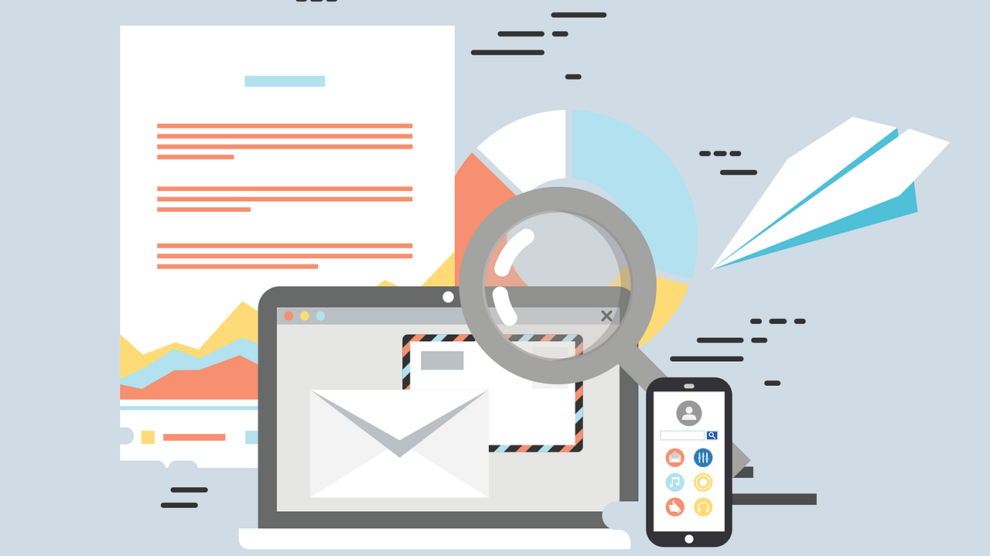The pace of technology, innovation, and the number of resources available to digital marketers today is just incredible and indicates how vigorously the digital marketing industry has grown over the years. Currently, there are more than 40 different marketing categories being used and practiced, including web analytics, SEO, SEM, SMM, video marketing, mobile analytics, and sales enablement, among others. What’s interesting is that the majority of the categories didn’t even exist a couple of years ago.
There is one category that was probably the first of a kind marketing tactic, which continues to perform well year after year since its inception. Yes, we are talking about email marketing. For years, email marketing has generated one of the highest ROIs for marketers. In fact, for every $1 spent, email generates $38 in ROI. Email marketing has given digital marketers a broader reach, allowing them to access a broader audience.
As a digital marketer or a business owner, email marketing should be your preferred tool for business growth. A well-executed email marketing campaign can reduce overall marketing costs, produce additional repeat business, generate leads, increase client loyalty, and increase sales.
Therefore, it is vital that you analyze and report your email marketing metrics just to ensure the effectiveness of your actions. Only by measuring the metrics can you can determine what has to be discontinued and what is best to implement for future marketing campaigns.
If you are a digital marketer or a business owner, it is important that you measure, report, and improve your metrics in order to stay competitive. Numbers don’t lie, and in this highly competitive business world, it is best that you rely on numbers more than your gut feeling.
With that said, this article contains everything you need to know about the importance of email marketing metrics and reporting to help you with your business approach and marketing strategy.
Let’s jump right into it.
What is Email Marketing?
Through email marketing, you can send commercial messages to targeted customers via email. The majority of businesses – both small and large – use email marketing for increasing sales, improving brand loyalty, and delivering important updates and information. It is a direct marketing approach and used to mass-target people.
However, with new regulations and stricter guidelines, mass-targeting customers with email has been somewhat discouraged.
Email marketing is still being practiced heavily because it is environmentally friendly and easy on the wallet. At its very best, it allows you to keep your customers informed by tailoring your marketing messages. At its worst, it can drive away prospective customers, if you don’t measure and report the metrics.
For example, suppose you have a broader audience to whom you send the same emails all the time without knowing their requirements. Now some of them may respond well to the emails, but others may not. You may not know, but others may have put you in spam. Without proper reporting and metrics, it is almost impossible to determine how your audience is responding to your emails. With proper metrics and reporting, even if your emails are poorly done, you will know what to change to retain the customers. But without proper metrics and reporting, it is difficult to know your customer likes and dislikes.
Each email campaign is different, especially if you have different marketing goals – growing a subscriber base, generating leads, etc. So, in order to properly analyze what customers are liking and disliking, you need to collect all kinds of data and information that relates to your campaign. Then, you need to strategically use these metrics to form a report. While creating a report sounds overwhelming, with the right tool, it becomes a hassle-free task.
The Importance of Metrics in Email Marketing
When we talk about email marketing, there are some key numbers that you should be watching. For starters, these numbers may prevent you from paying more than necessary for the email service you are using, sending emails that might be directed to the spam filter, and believe it or not, angering your prospective customers.
On the other hand, these numbers can help you tailor your communications to the interests of your potential customers who have already chosen to read them. There are dozens upon dozens of metrics that you can track and record for determining the overall success of your marketing campaigns. This is a crucial part of email analytics.
However, for the majority of marketers, knowing where to start may be confusing. There may be numerous questions about how to determine which metrics are important and which type of emails are entertained by subscribers and which are left unread.
The answers to these questions depend on the objectives of each specific email campaign. For instance, you would not track the same metrics for customer marketing campaigns as you would for lead generation email campaigns.
Focusing on the right metrics will enable you to analyze and improve your email marketing campaigns. While some metrics need to be monitored on a weekly basis, others need to be monitored on a monthly basis. Doing it weekly allows you to determine whether or not the campaign is going to be successful. If you are able to forecast, if your campaign is going to fall short or cross the bridge, you can make certain changes to your strategies as required to meet your revenue goals.
And, when you analyze the metrics on a monthly basis, you can tell which campaigns have the potential to be used in your future marketing strategies as well and whether you need to adjust your newly created campaigns that you are about to implement.
As with any other marketing campaign, you need to focus on those metrics that are associated with the ROI of your campaigns. To help you out, we have listed some of the most important email marketing metrics that every marketer needs to know, track, and report.
Top Email Marketing KPIs and Metrics You Should be Tracking
It doesn’t matter how well-created and optimized your emails are if they can’t produce the desired results. The first thing you need to determine when creating an email marketing campaign is what is the primary goal of your marketing.
Is it to convert existing leads into customers? Generate more leads? Or to grow a subscriber database?
Whatever your goal is, its result will depend on how well you track the associated metrics. With that said, here are the most prominent email marketing metrics that you should track for the sake of your campaign.
1. Open Rate
First things first, you need to know how many subscribers are actually opening your emails. Open rate is an important KPI that helps in understanding how well customers are receiving your messages. Open rate is an important metric that gives you insight into the success of your subject line copy. You want the emails you are sending to be opened by your subscribers. Subject lines play a vital role in determining whether a subscriber will open the email. To make sure that subscribers open the email, marketers should personalize the subject line with the subscriber’s first name. On the other hand, marketers can use other strategies as well, like the use of emojis in subject lines by and keeping subject lines short and direct. The average open rate of most email campaigns is about 24%. So, if you manage to achieve a higher open rate than this, it means your strategies are working as planned.
2. Click-Through-Rate (CTR)
The next metric is the CTR which can help you figure out the performance of your email campaigns. Click-through rate measures how many subscribers clicked on the provided links in the email. For instance, in the email, if you have provided a link for a new update, click-through rate will measure the percentage of users clicking on that link. There are a few different ways to increase CTR. When crafting an email, it is important to include all the necessary links intelligently throughout the mail. Then write an eye-catching CTA (call to action) wherever possible. Please note that CTRs are relatively lower than open rates. The links have to be unique and persuasive so that the subscribers are incentivized to click.
3. Conversion Rate
Conversion rate is another important email metric. It tells how many subscribers who clicked on a given link went on to complete a specific action. Unlike CTRs that measure how many people clicked on the link, conversion rate assesses how many users completed the action after clicking on that link.
For example, if you created an email campaign regarding a Cyber Monday sale, and included a link for subscribers to participate in that activity, conversion rate tells the percentage of users who clicked the link and made a purchase. Conversion rate is a promising metric that gives you insight into your ROI. When you know your investment and how many prospective buyers are converting, it becomes easy to analyze whether the money you spent for a campaign is paying off.
4. Number of Unsubscribes
Your email service provider has all the tools to determine how many users unsubscribed from your mailings upon receiving them. It is discouraging to see people unsubscribe, but it is an important metric because, if you find that your subscribers are unsubscribing only after you sent specific mails, then it is clear they didn’t liked them. Giving people the opportunity to unsubscribe builds trust because you are giving them a choice as to what type of content they want to receive from your company.
5. Bounce Rate
Bounce rate determines how many users didn’t receive your email. Tracking the bounce rate is important because it tells how many of your subscribers aren’t receiving your email. Hard bounces track problems that are persistent with email addresses and soft bounces track problems that are temporary. Marketers measure bounce rates against open rates because it gives them an idea about the quality of the subscriber list they have.
If the bounce rate is higher (experiencing hard bounces), there is a possibility that your subscriber list is full of fake email IDs. Or, there is a chance that the addresses have errors in them, or that they are old addresses subscribers no longer use. In order to decrease the bounce rate, you can make use of the double opt-in feature. Sending a verification email confirms the legitimacy of an email address and ensures that recipients are ‘OK’ with receiving emails from your brand. In this way, you will be able to create a genuine and quality subscriber list. As a result, the bounce rate will drastically decrease.
6. Spam Complaints
Not everybody will like receiving your emails. Some may even mark your emails as spam so as not to receive them again. While spam complaints are discouraging, you have to monitor them. If they get too high, there is a possibility your email service provider may take action against you and block your email account. Sending emails too frequently will only irritate your subscribers and could lead to a spike in spam complaints.
7. Engagement over Time
Another metric that you should track is engagement over time which can give you insight into the best times to send emails. Many Email service providers offer automation services, allowing you to pre-schedule emails based on a certain trigger. This trigger can be the time when your subscribers are most active on their desktop browsing mail, or when they access their mobile phones the most. The goal is to get your emails clicked and read. If you send emails at ungodly hours, there is a possibilitiy that your mails won’t even be opened. So, it is good to automate mailing times, so you don’t have to worry about doing it manually.
8. List Growth Rate
The list growth rate is the rate at which your email subscriber list is growing. It is easy to calculate. All you have to do is subtract the number of new subscribers from the number of unsubscribers, divide the resulting number from the total number of subscribers you have on your list, and then times the number by 100. You need to find productive ways to continually grow your email list. Write engaging emails, offer discounts, and engage potential subscribers through social media activities, etc.
9. Email Sharing
Email sharing, also known as forwarding rate, measures the percentage of subscribers who forwarded your email to a friend or shared it via social media. Email sharing is helpful in tracking audience behavior. It gives you an idea of how many advocates your brand has. This metric also tells you the percentage of subscribers who are recommending your emails to other users who are not your subscribers.
10. Overall ROI
Last but not least, one of the most prominent metrics that every digital marketer should track is the return on investment for your campaigns. It can be calculated by subtracting the total amount you made in sales from the total money you spent on executing the campaign, then dividing the number generated from the total money you spent on the campaign, and then multiplying it by 100.
Final Words
These are prominent email metrics that you should consider when making a report. Including all these metrics in your report will help you in determining the right email marketing strategy for both present and future marketing needs.
You can take the help of Whatagraph.com which offers a tool that can help you create and automate your email marketing reports in minutes. Whatagraph is trusted by top brands and marketing agencies. It can help you combine all the necessary data from multiple sources into a single report that is easy to understand and visually appealing as well.





